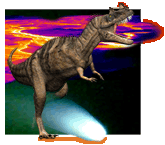Biostratigraphy and foraminiferal paleoecology of the Early Eocene Naredi Formation, SW Kutch, India
Type
The Naredi Formation in southwestern Kutch overlies the last Deccan Trap deposited during the early Paleocene. The lower part of the Naredi Formation (2.8-4.2 m from base) is of early Eocene (Ypresian) age (SBZ8, E4) based on larger foraminifera and rare planktic foraminifera, whereas the upper part (9.3-11 m, including the Assilina limestone) is of late early Eocene age (SBZ11, E6). There is no age control for the basal 0-2.8 m and between 4.2-9.3 m because microfossils are rare or absent. Small benthic and rare planktic foraminifera are common in three short intervals and indicate deposition in a brackish to normal marine inner shelf environment (SBZ8, E4), brackish environment (middle of section, no age control) and inner shelf to marginal marine environment (SBZ11, E6). Two phases of marine transgressions can be identified with the maximum transgressions in each phase coincident with the lower and upper foraminiferal assemblages. A paleosol indicated by root traces and burrows (5.9 m) represents a regression and possibly sequence boundary. PDF

